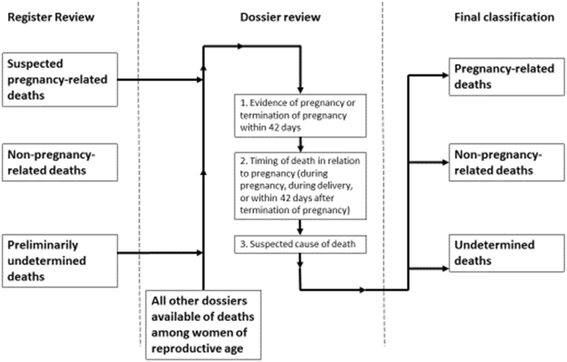Use of Rapid Ascertainment Process for Institutional Deaths (RAPID) to identify pregnancy-related deaths in tertiary-care obstetric hospitals in three departments in Haiti
- PMID: 28511722
- PMCID: PMC5434572
- DOI: 10.1186/s12884-017-1329-1
Use of Rapid Ascertainment Process for Institutional Deaths (RAPID) to identify pregnancy-related deaths in tertiary-care obstetric hospitals in three departments in Haiti
Abstract
Background: Accurate assessment of maternal deaths is difficult in countries lacking standardized data sources for their review. As a first step to investigate suspected maternal deaths, WHO suggests surveillance of "pregnancy-related deaths", defined as deaths of women while pregnant or within 42 days of termination of pregnancy, irrespective of cause. Rapid Ascertainment Process for Institutional Deaths (RAPID), a surveillance tool, retrospectively identifies pregnancy-related deaths occurring in health facilities that may be missed by routine surveillance to assess gaps in reporting these deaths.
Methods: We used RAPID to review pregnancy-related deaths in six tertiary obstetric care facilities in three departments in Haiti. We reviewed registers and medical dossiers of deaths among women of reproductive age occurring in 2014 and 2015 from all wards, along with any additional available dossiers of deaths not appearing in registers, to capture pregnancy status, suspected cause of death, and timing of death in relation to the pregnancy. We used capture-recapture analyses to estimate the true number of in-hospital pregnancy-related deaths in these facilities.
Results: Among 373 deaths of women of reproductive age, we found 111 pregnancy-related deaths, 25.2% more than were reported through routine surveillance, and 22.5% of which were misclassified as non-pregnancy-related. Hemorrhage (27.0%) and hypertensive disorders (18.0%) were the most common categories of suspected causes of death, and deaths after termination of pregnancy were statistically significantly more common than deaths during pregnancy or delivery. Data were missing at multiple levels: 210 deaths had an undetermined pregnancy status, 48.7% of pregnancy-related deaths lacked specific information about timing of death in relation to the pregnancy, and capture-recapture analyses in three hospitals suggested that approximately one-quarter of pregnancy-related deaths were not captured by RAPID or routine surveillance.
Conclusions: Across six tertiary obstetric care facilities in Haiti, RAPID identified unreported pregnancy-related deaths, and showed that missing data was a widespread problem. RAPID is a useful tool to more completely identify facility-based pregnancy-related deaths, but its repeated use would require a concomitant effort to systematically improve documentation of clinical findings in medical records. Limitations of RAPID demonstrate the need to use it alongside other tools to more accurately measure and address maternal mortality.
Keywords: Haiti; Maternal mortality; Pregnancy-related deaths; Rapid Ascertainment Process for Institutional Deaths (RAPID).
Figures
Similar articles
-
Use of routinely collected data to assess maternal mortality in seven tertiary maternity centers in Cameroon.Int J Gynaecol Obstet. 2011 Dec;115(3):240-3. doi: 10.1016/j.ijgo.2011.07.018. Epub 2011 Sep 17. Int J Gynaecol Obstet. 2011. PMID: 21930267
-
Maternal mortality and related factors in Ejisu District, Ghana.East Afr Med J. 1994 Oct;71(10):656-60. East Afr Med J. 1994. PMID: 7821246
-
The triple threat of pregnancy, HIV infection and malaria: reported causes of maternal mortality in two nationwide health facility assessments in Mozambique, 2007 and 2012.BMC Pregnancy Childbirth. 2015 Nov 9;15:293. doi: 10.1186/s12884-015-0725-7. BMC Pregnancy Childbirth. 2015. PMID: 26552482 Free PMC article.
-
Underreporting and misclassification of maternal mortality in Taiwan.Acta Obstet Gynecol Scand. 1997 Aug;76(7):629-36. doi: 10.3109/00016349709024602. Acta Obstet Gynecol Scand. 1997. PMID: 9292636 Review.
-
Maternal mortality in the developed world: a review of surveillance methods, levels and causes of maternal deaths during 2006-2010.Minerva Ginecol. 2017 Dec;69(6):608-617. doi: 10.23736/S0026-4784.17.04111-9. Epub 2017 Jul 17. Minerva Ginecol. 2017. PMID: 28714660 Review.
Cited by
-
Systematic identification of facility-based stillbirths and neonatal deaths through the piloted use of an adapted RAPID tool in Liberia and Nepal.PLoS One. 2019 Sep 19;14(9):e0222583. doi: 10.1371/journal.pone.0222583. eCollection 2019. PLoS One. 2019. PMID: 31536573 Free PMC article.
-
Implementation of maternal and perinatal death surveillance and response (MPDSR) in humanitarian settings: insights and experiences of humanitarian health practitioners and global technical expert meeting attendees.Confl Health. 2022 May 7;16(1):23. doi: 10.1186/s13031-022-00440-6. Confl Health. 2022. PMID: 35526012 Free PMC article.
-
Incompleteness and misclassification of maternal death recording: a systematic review and meta-analysis.BMC Pregnancy Childbirth. 2023 Nov 15;23(1):794. doi: 10.1186/s12884-023-06077-4. BMC Pregnancy Childbirth. 2023. PMID: 37968585 Free PMC article.
References
-
- Sustainable Development Goals: Goal 3: Ensure healthy lives and promote well-being for all at all ages [http://www.un.org/sustainabledevelopment/health/]. Accessed 15 May 2017.
-
- Van Poppel F, Van Dijk J. The development of cause-of-death registration in the Netherlands, 1865–1955. Continuity and Change. 1997;12(2):265–287. doi: 10.1017/S0268416097002932. - DOI
-
- Streatfield PK, Alam N, Compaore Y, Rossier C, Soura AB, Bonfoh B, Jaeger F, Ngoran EK, Utzinger J, Gomez P, et al. Pregnancy-related mortality in Africa and Asia: evidence from INDEPTH Health and Demographic Surveillance System sites. Glob Health Action. 2014;7:25368. doi: 10.3402/gha.v7.25368. - DOI - PMC - PubMed
MeSH terms
LinkOut - more resources
Full Text Sources
Other Literature Sources
Medical
Research Materials


